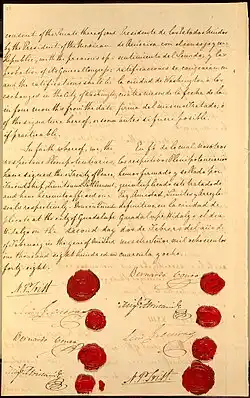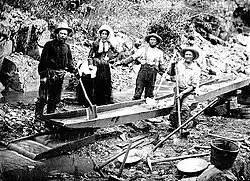The Mexican-American War was a conflict which was fought between the Republic of Mexico and the United States of America between April 1846 and February 1848. The war broke out as a result of a long-running dispute between the two nations over possession of Texas, the spark being the annexation of the Republic of Texas by the US in December 1845. The war was a one-sided military clash in which the Mexicans were soundly defeated by the Americans, culminating in the occupation of Mexico City in September 1847. The Treaty of Guadalupe Hidalgo followed. Through this Mexico ceded a great stretch of territory running from modern-day Texas west through New Mexico, Colorado, Arizona, Utah and Nevada to California and southern Oregon. The war, combined with the California Gold Rush that began right as it was coming to an end, saw a surge in westward migration in the United States and the opening up of the American West.[1]
Research your ancestors on MyHeritage
Mexican-American War chronology of eventsMexican-American War chronology of events
As far back as the middle of the sixteenth century the Spanish had claimed control over most of what is now the Sun Belt region of the United States, lands running from Florida all the west to California. Control over Florida, Alabama, Mississippi and Louisiana had been ceded to France over time and these lands were in turn sold by the French government to the United States through the Louisiana Purchase of 1803. The other lands, though, approximating with the modern-day US states of Texas, New Mexico, Colorado, Arizona, Utah, Nevada, California and southern Oregon, passed to the nascent state of Mexico when it emerged as an independent country from its war of independence from Spain in 1821. Moreover, by then there were growing communities of Hispanic settlers in some of these regions, with significant Spanish colonies having been formed in California and Texas from the late 1760s onwards.[2]
The young nations of the United States and Mexico were soon in conflict over their respective borders. Texas provided the flash point. The Adams-Onis Treaty of 1819 between the US and Spain had set the boundary point at the Sabine River in return for Spanish acknowledgement of the US in control of Florida, however subsequent administrations in Washington argued that the treaty did not fully apply to the new Mexican state.[3]

When American settlers began colonizing the region between the Sabine River and the Rio Grande in the 1820s and early 1830s a conflict started to brew. Eventually these settlers declared the creation of a Republic of Texas in 1835 and broke away from Mexican rule by early the next year in the midst of the Mexican Federalist War. This Texan state always had closer ties to the US than to Mexico and Washington recognized its government in 1837. It eventually annexed the Republic of Texas in December 1845 and immediately admitted Texas as the 28th US State. Further disputes over the setting of a new border at either the Rio Grande or the Nueces River arose within weeks and these eventually spiralled into war between the US and Mexico in April 1846, four months after the annexation of Texas.[4]
The resulting Mexican-American War was a brief one. Mexico had been weakened by decades of internal instability since independence over divisions between federalists and those who preferred strong regional independence. It was, in any event, less militarily and economically advanced as a country than was the United States and hence less able to fight the war effectively. Naval blockades were put in place in the Gulf of Mexico and a US army under General Winfield Scott invaded Mexico, occupying the capital, Mexico City, in September 1847. Having been comprehensively defeated, the Mexican government had little option but to accept the Rio Grande as the border between Texas and Mexico and ceded extensive further territory west to California and southern Oregon through the Treaty of Guadalupe Hidalgo in February 1848.[5]
Extent of migration after the Mexican-American WarExtent of migration after the Mexican-American War

The conclusion of the Mexican-American War and the US annexation of a vast swathe of territory running from Texas all the way west to California opened up a period of intense westward migration in US history. In the immediate term, the largest element of this was the movement of some 300,000 people out to California between 1848 and the middle of the 1850s as part of the California Gold Rush. Many went by land, though a substantial proportion either went by sea all the way south around Cape Horn at the southern end of South America and back north again, or south to Panama and then overland across the Isthmus there before taking ship to California on the Pacific side.[6]
This was the most tangible element of the migration associated with the Mexican-American War, though in the long term the war opened up the entire American West to migration. For instance, many people began settling villages and towns in Colorado, New Mexico, Arizona and Utah in the years and decades that followed. This westward expansion and colonization of Native American land was also much more intense than had been the relatively thin and sporadic settlement of the same regions by Spanish/Mexican settlers in the century or so prior to the war. Tens of millions of Americans today in the region from Texas westwards to the Pacific Ocean will have an ancestor who migrated into this region to some degree because of the events of the Mexican-American War.[7]
Demographic impact of the Mexican-American WarDemographic impact of the Mexican-American War
The Mexican-American War changed how a substantial proportion of North America has been populated in modern times. There was already a growing level of migration from Mexico and other lands into places like California in the first half of the nineteenth century. The war though changed the pace at which this was occurring and where the settlers were coming from, with the south-western United States becoming a place which was henceforth primarily settled by Americans and other groups who were migrating to the United States in increasing numbers from the 1840s onwards like the Irish, Italians, Germans, Poles and Jews, whereas prior to 1848 the settlement which was occurring in California was primarily of people of Hispanic ethnicity. Thus, the ethnic landscape was changed here because of the war, along with the scale of the migration into the region. One out of every four Americans lives today in the territory acquired through the annexation of the Republic of Texas and the Treaty of Guadalupe Hidalgo.[8]
See alsoSee also
Explore more about the Mexican-American WarExplore more about the Mexican-American War
- U.S. Public Records Index records collection on MyHeritage
- 1850 United States Federal Census records collection on MyHeritage
- 1860 United States Federal Census records collection on MyHeritage
- Western United States, Marriage Index, 1838-2016 records collection on MyHeritage
- Texas Marriages, 1837-1965 records collection on MyHeritage
- 1852 California State Census records collection on MyHeritage
- Mexico, Baptisms, 1560-1950 records collection on MyHeritage
- Finding Your Ancestors in the Republic of Texas at Legacy Family Tree Webinars
- To Live and Die in California: Researching Vital Records at Legacy Family Tree Webinars
- Research Arizona Ancestors at Legacy Family Tree Webinars
- Researching in New Mexico at Legacy Family Tree Webinars
- Padrones of the Past: Colonial-era Censuses of Mexico at Legacy Family Tree Webinars
References
- ↑ https://www.history.com/topics/19th-century/mexican-american-war
- ↑ https://www.loc.gov/collections/california-first-person-narratives/articles-and-essays/early-california-history/
- ↑ https://www.tshaonline.org/handbook/entries/adams-onis-treaty
- ↑ https://www.tshaonline.org/handbook/entries/republic-of-texas
- ↑ https://www.history.com/topics/19th-century/mexican-american-war
- ↑ https://www.loc.gov/collections/california-first-person-narratives/articles-and-essays/early-california-history/forty-niners/
- ↑ https://www.history.com/topics/19th-century/westward-expansion
- ↑ https://worldpopulationreview.com/states

